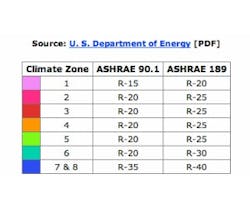Energy requirements for buildings have progressively become more rigorous. Units of resistance to heat flow (R-factor) are now aligned with maps of the U.S. by climate zone, with minimum values of R=20 for warm climates to R= 40 in extremely cold climates. R-values per inch for commonly used roof insulation boards range from 2.7 for wood fiber, perlite, and foamed glass to 5 for extruded polystyrene and 5.6 for isoboards.
Meeting Code-Mandated R values
If, for example, you need an R-value of 25, you would need 9 inches for perlite (!) to 4.46 inches of thickness for isoboards. To find your needed R-value, see the climate zone table and maps above.
Does Thickness Matter?
In commercial roof design, the thickness of the wood nailers used at roof perimeters needs to match the thickness of the thermal insulation (see illustrations above). However, 1 inch doesn’t always mean 1 inch.
Why?
Everyone has heard of a 2x4, but few people realize that the actual height and width of a 2x4 is really somewhere close to 1 1/2 x 3- 1/2 inches, depending on the dryness of the material and milling methods. Similarly, a 1x ("one-by") is only about 3/4 inches in thickness, according to Wikipedia. To be safe, multiply the required inches of thickness by 1.5. This means that for insulation with high R-values, such as isoboard, you would actually need 6.7 inches of lumber, not 4.46. That is a lot of wood, plus metal roof edging must extend below the exposed nailer.PageBreak
Updates on Treated Wood in Roofing
Richard (Dick) L. Fricklas was technical director emeritus of the Roofing Industry Educational Institute prior to his retirement. He is co-author of The Manual of Low Slope Roofing Systems, and continues to participate in seminars for the University of Wisconsin and RCI Inc., the Institute of Roofing, Waterproofing, and Building Envelope Professionals. His honors include the Outstanding Educator Award from RCI, William C. Cullen Award and Walter C. Voss Award from ASTM, the J. A. Piper Award from NRCA, and the James Q. McCawley Award from the MRCA. Dick holds honorary memberships in both ASTM and RCI Inc.
Until very recently, the standard preservative treatment for roof nailers was copper chromium arsenate (CCA). Before that, it was creosote, also a toxic material. If an untreated wood nailer disintegrates while in service, the roof can be vulnerable to wind blow-off.An excellent essay on the subject can be found in Metal Roof and Wall Panel Components in Contact with Preservative Treated Lumber published by the Metal Construction Association here.
In this paper, the MCA suggests “the use of a polymeric membrane material as a barrier between the metal panel and the wood. In those types of installations, the choice of compatible metal fasteners is also critical to the integrity of the metal roof or wall assembly.” It also notes that manufacturers of the newest wood preservative chemicals recommend that unpainted galvanized or Galvalume sheet panels and aluminum not be used in direct contact with this type of wood.
In addition to the MCA, the National Roofing Contractors Association (NRCA) has also updated their recommendations on the use of treated wood. The NRCA recognizes the lack of long-term corrosion performance of newer preservative-treated lumber in contact with metal fasteners, panels and flashing. Their guidelines include the following:
- Aluminum fasteners, flashings, and accessory products should not be used in direct contact with any treated wood. Alkaline copper quarternary-treated wood is not compatible with aluminum.
- Uncoated metal and painted metal flashings and accessories except for the 300-series stainless steel should not be used in direct contact with treated wood. Metal products except stainless steel may be used if separated from treated wood by a spacer or barrier such as single-ply membrane or self-adhered polymer-modified bitumen material.
- NRCA also states: “In many instances, the use of non-treated, construction-grade wood is suitable for use in roof assemblies as blocking or nailers, provided reasonable measures are taken to ensure the non-treated wood remains reasonably dry when in service. Where a specific construction detail provides for a secondary means of waterproofing, NRCA now considers the use of non-treated, construction-grade wood to be an acceptable substitute for treated wood.”
Spray On the Savings
How to evaluate spray foam insulation’s viability for your roof.
5 Steps to Extend Roof Life
Keys to successful in-house roof management.
Why Do Flashings Fail?
Causes and solutions for parapet problems.
About the Author
Richard L. Fricklas
Richard (Dick) L. Fricklas received a Lifetime Achievement Award and fellowship from RCI in 2014 in recognition of his contributions to educating three generations of roofing professionals. A researcher, author, journalist, and educator, Fricklas retired as technical director emeritus of the Roofing Industry Educational Institute in 1996. He is co-author of The Manual of Low Slope Roofing Systems (now in its fourth edition) and taught roofing seminars at the University of Wisconsin, in addition to helping develop RCI curricula. His honors include the Outstanding Educator Award from RCI, William C. Cullen Award and Walter C. Voss Award from ASTM, the J. A. Piper Award from NRCA, and the James Q. McCawley Award from the MRCA. Dick holds honorary memberships in both ASTM and RCI Inc.

